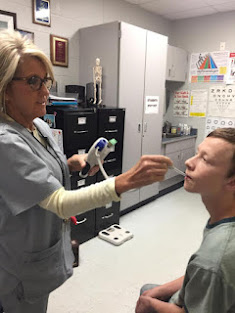The House left more than $1 billion unappropriated, and even more in the budget reserve or “rainy day” fund. Legislators are planning a tax-reform package that would reduce revenue during the biennium that starts July 1.
Schuster and Eva Stone, a nurse practitioner who is the health services manager for Jefferson County Public Schools, had asked a House budget subcommittee Jan. 18 for $18 million over the next two years to ensure that every Kentucky school building has a full-time nurse in it – all day, every day.
This amount was based on a survey of school-nurse salaries in bordering states and other Southern states, said Schuster. The total salary and benefits, for each full-time school nurse would be $56,598.
Schuster said the advocates hope that the benefits of placing a nurse in every Kentucky school would be researched by the University of Kentucky College of Nursing.
Stone pointed out that Kentucky is in the bottom 10 states for multiple health conditions in children, including mental health, diabetes, asthma, obesity and oral health, and that having a full-time nurse in the building would help to address these conditions.
“With all these negative health indicators we have in the state of Kentucky, having some systems in place to try and address these things early on can have a big impact for children, both educationally and for their long-term health,” she said.
Stone added that research shows that schools with nurses have improved attendance rates with lower absenteeism, higher high-school graduation rates, decreased use of local emergency department services, reduced transmission of infectious diseases, earlier diagnosis and treatment of physical, mental and academic problems, better management of chronic health conditions and better mental physical and mental health screening.
“A child’s ability to learn is directly related to health status,” she said, She adding that more than 120,000 of the 638,236 children in Kentucky’s public schools have a chronic health condition.
Stone said 29 of the state’s 171 school districts have no school nurses, and many more have part-time nurses or nurses who are shared among several schools.
Schuster said that having a part-time nurse is better than no nurse, but is not optimal: “The ability of the students to really relate to and get to know the nurse, and for the nurse to get to know those students, when she’s spread across several buildings on campus is just not the most effective.”
Stone said the school secretary often ends up taking care of nursing issues when a school does not have a full-time nurse, and is more likely to send a student home than a nurse would.
Rep. Tina Bojanowski, D-Louisville, a teacher, said she wasn’t sure how we got to a place where we don’t have a full-time nurse in every building.
“Let me just explain to you what happens when you don’t have a school nurse,” she said. “All of the ‘Band-Aid and boo-boo’ issues are brought to the school secretary. . . . but all of those other areas that would really help our students become more healthy and to be more in the position where they can be learning won’t be happening.”
Schuster said that in
the many years the task force has been working to get a nurse in every school, they haven’t heard from a lawmaker who doesn’t support the idea, but they also haven’t been able to put money in the budget to make it happen – but now is the time.
“Covid has brought out all of these issues and exacerbated them and shown the inequities, and shown the mental health and its effect on academics and physical health,” she said. “We plead with you to really strongly consider putting this money in the budget.”
